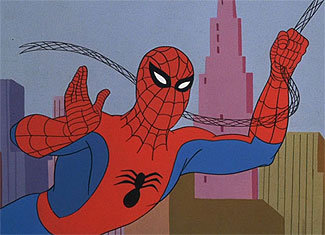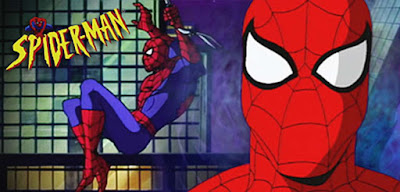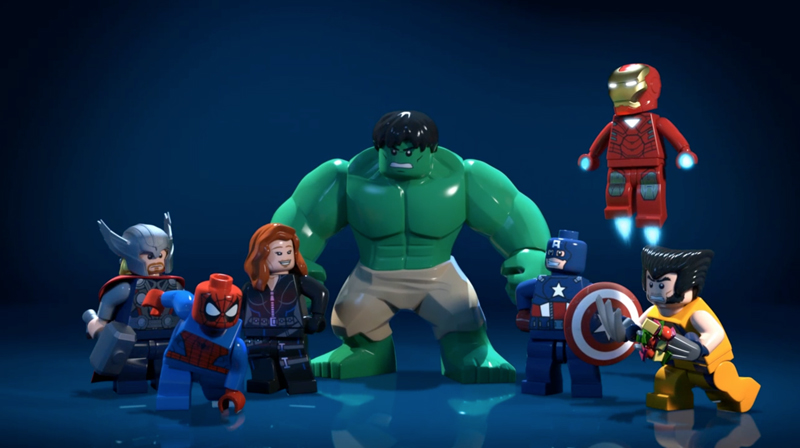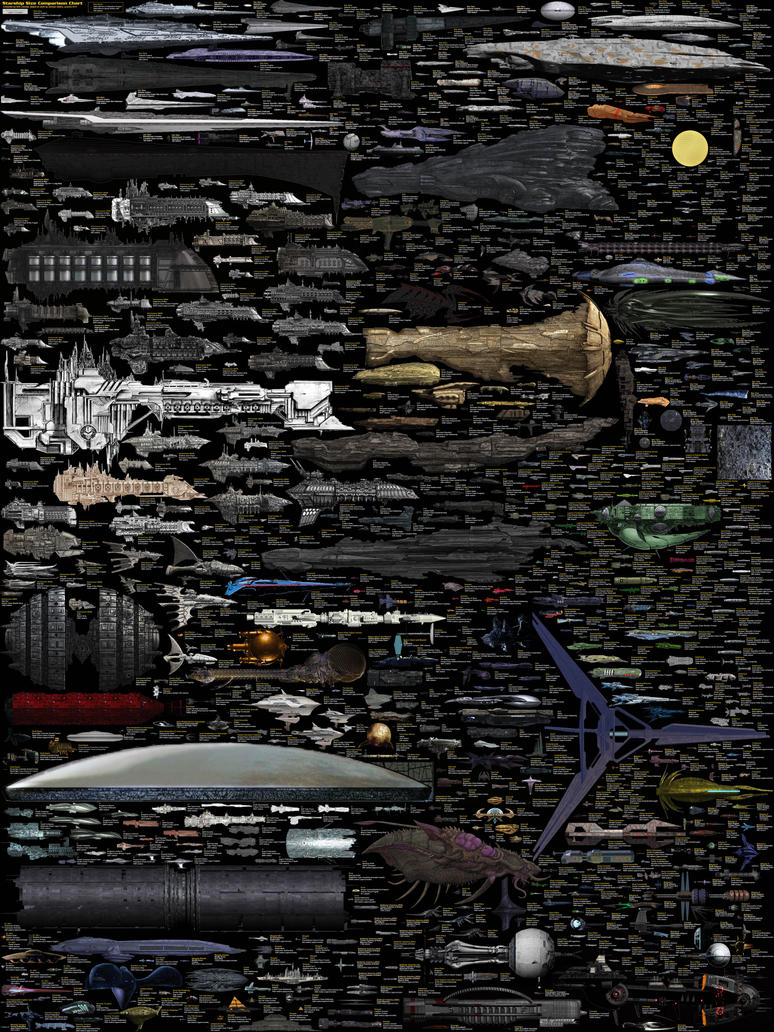Well, I've been watching lots and lots of Spider-Man lately. I'm on a bit of a Spidey-thon. Arachnophilia. There have been more than a couple of screen Spider-Men over the years, and with Marvel gearing up for the mighty Spider-Verse event, it seemed apropos to catch up on them all. They all have an official reality numerical designation, you know. So, here we are, a quick overview and opinion of all the Spider-Man series ever to show up on television. Unless I've missed one.
Spider-Man (1967-70)
The very first Spider-Man series was an animation, its imagery based on the classic Ditko/Romita comics. While it it lasted for three seasons, it's not great. Focusing on Peter Parker's work at the Daily Bugle to the detriment of any other aspects of his personal life, it sees Betty Brant as his main love interest, although not much is made of this. He mostly divides his time between getting pictures of himself in costume and clearing his name as various villains scheme to set him up as a criminal. Pretty much every first season episode sees J. Jonah Jameson running a story outing Spider-Man as a thief, before having to retract it at the end. The voices are strange; Paul Soles provides Parker's voice, nasally and higher-pitched, before putting on a deep, “heroic” voice for Spider-Man's scenes. It's almost like an Adam West Spider-Man, which doesn't work at all. On the other hand, Paul Kligman is absolutely spot-on perfect as Jameson. He's probably the best screen Jonah until J.K. Simmons in the 2000 movies.
The villains are pretty flimsy. While the first season brought in various foes from the comics, they were shabby, dumbed down version. Norman Osborn is a magic-obsessed prat, which admittedly explains his tendency to dress as a goblin. The Lizard is a scheming freak who accidentally transformed himself while testing a swamp fever innoculation. Quite often, these episodes were interspersed with more generic stories, with Spidey fighting ice-men from Pluto and other such oddities. In the second and third season, almost every episode involved a faceless space monster or magical foe, often utilising recycled footage from Rocket Robin Hood, a short-lived crappy cartoon series from the same studio. Not the best example of a Spidey cartoon, but it's good fun and it did give us the classic theme tune. Altogether: Spider-Man, Spider-Man, does whatever a spider can...
Spidey Super Stories (1974-77)
Argh, this is so sweet! Spidey Super Stories are tiny little adventure skits aired as part of The Electric Company. They're distinctly limited, with Spider-Man played mute by a dancer, only communicating in speech bubbles. We never see him out of costume or doing anything much other than fighting villains created for the show, like the Tickler, the Spoiler and Dr. Fly. It's cheap, bares only the slimmest resemblance to the comics and is very much for young children, but god it's got charm. The Super Stories were narrated by some pretty excellent talent, not least a young Morgan Freeman, who played various small roles in the show as well. Everything is better with Morgan Freeman narrating. He even got to play Dracula. The show was followed by a comicbook version by Marvel, which introduced various Marvel characters to younger readers. They also included an evil anti-Spider-Man called Web-Man. Awesome stuff.
The Amazing Spider-Man (1977-79)
The first proper live-action Spidey production, this began with the made-for-TV 1977 movie titled simply Spider-Man, which was released theatrically across the world, becoming the first Spider-Man movie. This was well-received enough to spawn a full series, although only a further twelve episodes were made. It was only really a TV phenomenon in the States; overseas it was mostly retooled as theatrical movies, with the two-parter “The Deadly Dust” released as Spider-Man Strikes Back and the final feature-length episode “The Chinese Web” released in 1980 as Spider-Man: The Dragon's Challenge. Videos of these used to knock around a lot when I was a kid.
Nicholas Hammond is pretty good as Peter Parker, even if he is the wettest version of the character ever (and that includes Toby Maguire). The rest of the cast are generally fine, although I'm not enamoured with either of the Jamesons. David White is really, completely wrong, and though they replaced him for the main series, Robert Simon is still not right for the part. They're just not nasty enough. Jameson needs to be a complete angry bastard. Michael Pataki is amazing as Cpatain Bambera, the major police character. Trying to make a Spider-Man series on a 70s TV budget was probably a bit much to ask, and the stunts are a bit ropey. Still, sometimes they really pull it off, and it's generally entertaining; more so in the series than the pilot, actually, which spends too long setting up Spider-Man's origins. There's a serious lack of strong villains though, with the pilot involving a hypnotic guru. There are some mind-control gasses and an evil Spidey-clone though. A bit like Spidey Super Stories.
Spider-Man (1978-79 Toei series)
Now, this is insane. Marvel sold the rights to a Japanese company called Toei in return to rights for some of their properties, and so they made a tokusatsu series. Which, for the westerners among us, is the Power Rangers school of television. So instead of Peter Parker being bitten by a radioactive spider, Takuya Yamashiro is given powers by an alien called Garia, from the Planet Spider, in order to fight the villainous Professor Monster. He also gives him a spaceship called the Marveller. Oh, and this spaceship turns into a giant robot called Leopardon. Apart from the outfit and a couple of powers, Supaida-Man has barely any resemblance to the Spider-Man we know. It's as entertaining as these kinds of shows ever are, though, so if you want some mindless fun, you could do worse. Marvel liked it enough that they made it available on their website at one point, and Takuya is even expected to turn up in the upcoming Spider-Verse comic series. Things we learned from this series: the Japanese term for web-slinger is apparently “Spider-String.”
Spider-Woman (1979-80)
I'm fond of Spider-Woman, even though she was invented to retain copyright over the “Spider” trademark. This is one of the cheapie cartoon series that used to clutter up the airwaves on Saturday mornings, with the expected recycled frames and poor animation grade. Still, it's pretty good fun if you're not expecting anything special. I'm including it here because Spider-Man does make a couple of guest appearances, including in the first episode. Jessica Drew is a fine character, and really is one better than Peter Parker in most respects. She edits her own magazine instead of just taking pictures, has all of Spider-Man's essential powers plus flight and electrical “venom blasts” as well, and she does that cool spinny thing that Wonder Woman does. She battles robot mummies from space (a couple of years after Pyramids of Mars, but surely coincidental), Amazon warrior women and barely recognisable versions of established Marvel villains. Shame about her sexist sidekick and the racist bits, but it was the seventies.
Spider-Man (1981-82)
One of two Spidey cartoons that aired on separate networks in the 80s. Although officially separate, there was some crossover between the two. It wasn't as popular as stablemate Amazing Friends but is actually rather better. Pretty decent animation and a faithful look for the characters, although Parker's a bit of a prettyboy. There are plenty of villains from the comics, both from Spidey's rogues gallery and the Marvel universe beyond. For this series, Dr Doom was cribbed from the Fantastic Four to be the main recurring villain bent on world domination. It's basically a sequel to the 60s series, with Betty Brant as the main romantic interest again and another brilliant Jameson with the voice of William Woodson. What is it about Jonah that makes him the standout character in most series? Aunt May is a bit mindless, though. Neil Cross makes for a great Green Goblin, and returned for the 90s series. Definitely one of the better animated versions of Spider-Man. It was released on DVD as Spider-Man 5000, for some reason.
Spider-Man and His Amazing Friends (1981-83)
Well, this is cute. Peter Parker, Bobby Drake and Angelica Jones are the Spider Friends, three teenagers who have superpowers. Aunt May is, naturally, oblivious. The original plan to have the Fantastic Four's Human Torch in the gang fell through due to rights issues, so Spider-Man and Ice Man are joined by Firestar, a fire-throwing mutant, who was created for this series but became popular enough to appear in the comics. Together, the three of them battle various villains and low-level threats. The set-ups for the stories are weirdly askew. In one, the three of them go to a superhero fancy dress party. As fun as it is to see Firestar cosplay as Spider-Woman and Ice Man as Captain America, Spider-Man is lazy enough to dress as himself. The Green Goblin attacks, wanting to turn everyone in the city into goblins (in this version, Norman Osborn is a reasonable guy but transforms into the Goblin, rather like the Lizard). Even more baffling is the episode in which the Chameleon invites the Spider Friends to a party, along with Captain America, Doctor Strange, Shanna the She-Devil and a particularly stupid version of the Sub-Mariner, and then proceeds to bump them off in ridiculous ways. Fortunately, Miss Lion, Aunt May's dog, can smell through his disguises. Is there any greater cartoon sin than the cute, funny dog? Still, Frank Welker's in it, and that's always a plus.
If you're looking for The Incredible Hulk and the Amazing Spider-Man (or the reverse), that was this show repackaged with episodes of the Hulk animated series of the same time. The Marvel Action Universe was the repackaged bundle of various cartoon shows, including both 80s Spidey series, The Incredible Hulk, The New Fantastic Four, Pryde of the X-Men and non-Marvel titles like Robocop and Dungeons & Dragons.
Spider-Man (1994-98)
The best of all the series, still unbettered. This was a Marvel in-house project that followed the success of Saban's X-Men series, although having two different studios owning the rights didn't stop the two shows crossing over. Indeed, almost every major Marvel hero of the nineties turned up at some point. Much better than X-Men, or the Marvel Action Hour cartoons that followed it, it stands up well today. It's pretty breathless, charging through plots in order to fit its brief runtime, but packs the emotional beats of Peter Parker's story in well, something other series didn't always manage. Most of the best-remembered storylines from the comics were adapted, with tweaks – for example, Mary-Jane taking on some of Gwen Stacy's storylines. However, it was hobbled somewhat by network execs vetoing elements that were considered too violent or upsetting for kids. So, in spite of its relatively mature writing, it was bowdlerised. Gunshots never connected and no blood was allowed. Even Morbius, the Living Vampire, had to cry for “Plasma!” and sucked it out through suckers on his hands, because fangs were too nasty (actually pretty cool, albeit baffling). Even the word “sinister” was considered to much for the little ones, so the Sinister Six became the Insidious Six. This despite X-Men having a villain called Mr. Sinister.
Spider-Man Unlimited (1999/2001)
The 90s series was successful enough to get a spin-off, and deeply weird it was. Fair enough going in a new direction, but this was peculiar, taking place on the mysterious Counter-Earth on the opposite side of the sun. Spider-Man hitches a ride on a spaceship to stop a powered-up Venom and Carnage, and ends up on a world ruled by the gene-splicing High Evolutionary and his mutant animal knights, the “Beastials.” He gets himself a new costume and meets various alternative versions of characters, including a heroic Green Goblin and a version of Electro who's an actual electric eel. So, yeah, weird. It didn't last beyond one season. Original pitches including a world in which Uncle Ben never died and Peter became Venom sound more interesting than what we actually got, but fiddly rights issues with Sony and objections from Marvel put paid to that. It's pretty much standard sci-fi cartoon fare with Spider-Man grafted on, although I do like his hi-tec costume (except the web cape, that's naff).
Spider-Man: The New Animated Series (2003)
AKA “MTV Spider-Man.” I'm afraid I never made it to the end of episode one. Ostensibly a follow-up to the first of the Sam Raimi movies, this is an absolute mess. With awful CG animation that looked dated even on broadcast (seriously, Reboot looked better than this) and witless dialogue, this is poor. Neil Patrick Harris voiced Spider-Man though, which is pretty cool. Pity they couldn't have given him some better material.
The Spectacular Spider-Man (2008-09)
Finally a worthy successor to the 90s Spider-Man, this series ran only for two seasons due to rights issues between Sony and Marvel. It's a real shame – this is genuinely good stuff. While the artwork is unusually simplified and cutesy for a Spidey cartoon, it's effective and works well with the fast-paced, action-packed stories. The series takes many of the classic stories and characters from the comics as inspiration, but streamlines it all, with some characters being combined to simplify things. We actually get to see Peter at college for most of the series, grounding the character again. This really is excellent stuff, properly entertaining and with a lot of heart. One oddity is that, due to more rights issues, the Kingpin couldn't feature, so his place was taken by Tombstone. Spidey spends much of his time battling the various crime syndicates in the city, with Norman Osborn tasked by Tombstone to create superpowered foes to keep him distracted from the real crime. It's a clever approach. Also, Mysterio is hilariously camp, and it has the angriest, shoutiest Jameson ever. The theme tune by The Tender Box is incredibly catchy. Sadly, due to the cancellation, we never got to see Peter finally get together with Gwen Stacy, leaving us hanging. I may never forgive this.
Ultimate Spider-Man (2012-present)
The current Spider-Man series, and really not bad. This takes Spidey's wisecracking to its logical limit, breaking the narrative for comical asides every two minutes, which is either funny or irritating, depending on your taste. Unencumbered by the same restrictions as the movies, the Marvel Animation studio can cross over to other series as much as they like. So this sees Spidey join the Avengers as part of a new team of young heroes, along with Nova, White Tiger, Iron Fist and Power Man. All of whom live and school with Peter, with Aunt May seemingly oblivious to the proliferation of superhumans living right under her nose. In fact, May is barely recognisable, having reached the end point of her gradual evolution from doddery old mare to ass-kicking middle-aged raver.
With Brian Bendis in creative control, this mixes his Ultimate Spider-Man comics line with various elements from the mainstream comics and the movie franchises. The series features heroes and villains from throughout the Marvel universe, and crosses over with sister series The Avengers: Earth's Mightiest Heroes (which is very good) and Hulk and the Agents of SMASH (which is dreadful). There are some great voice stars too, including J.K. Simmons as J. Jonah Jameson and Clark Gregg voicing Agent Coulson. It's good fun, and even features the Guardians of the Galaxy in a couple of episodes. My mate Rob “the Riddler” Riddle calls it “not bad, for a 'modern' cartoon,” which is pretty high praise from him. It's just been relaunched with the subtitle Web Warriors, which will see multiple Spider-Men come together, including Donald Glover voicing Miles Morales.
Fun fact: Christopher Barnes, the voice of Spider-Man in the 90s series, voices Electro in this series, and is back to play the alt-Spidey Spyder Knight.
LEGO Marvel Superheroes: Maximum Overload (2013)
This is just great. It's only twenty-two minutes long, and it's a blatant attempt to sell a video game, but it's just so funny. “My Spider-Angst is tingling!” It's a brilliant pastiche of the current Marvel films, only with added Spider-Man. Doctor Octopus looks genuinely good in Lego, the Mandarin gets the funniest lines and there are kebabs. And J.K. Simmons, once again, as J. Jonah Jameson. Short but wonderful.




























